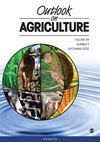Youth engagement in livestock production and marketing in East Africa
IF 2.6
3区 经济学
Q1 AGRICULTURE, MULTIDISCIPLINARY
引用次数: 0
Abstract
There is limited empirical evidence about how youth engage in livestock production in East Africa. The primary objective of this article is to better understand youth engagement in the livestock sector, namely commercialization and marketing. We compare youth to non-youth in four areas: livestock asset ownership, access to and use of services and improved practices and lastly, market participation. Our framework draws upon agricultural transformation concepts to suggest a tentative pathway through which livestock can support youth in transitions. We draw upon quantitative data and analyze and compare youth to nonyouth in intensive and extensive livestock systems in Kenya, Uganda, Ethiopia, and Tanzania and investigate four livestock systems, dairy, extensive ruminants, pig, and chicken systems. The results showed that there were no systematic youth-specific trends across the asset ownership, levels of commercialization or market participation. Also, low asset ownership did not generate observable youth specific differences in market participation. Rather, education and improved practices correlate with higher levels of market participation. Exploring how livestock are acquired and implications upon asset-based approaches is recommended to better understand the potential of livestock as a source of income during youth transitions in different livestock systems. More evidence is needed to inform and tailor policy approaches to support equitable opportunities in the livestock sector better. Research into understanding how social factors, including gender, shape youth opportunities and constraints, is needed.东非青年参与畜牧业生产和营销
有关东非青年如何参与畜牧业生产的经验证据十分有限。本文的主要目的是更好地了解青年参与畜牧业的情况,即商业化和营销。我们将青年与非青年在以下四个方面进行了比较:牲畜资产所有权、服务的获取和使用、改进的实践以及最后的市场参与。我们的框架借鉴了农业转型概念,提出了畜牧业支持青年转型的初步途径。我们利用定量数据,对肯尼亚、乌干达、埃塞俄比亚和坦桑尼亚集约型和粗放型畜牧系统中的青年与非青年进行了分析和比较,并对奶牛、粗放型反刍动物、猪和鸡四种畜牧系统进行了调查。结果表明,在资产所有权、商业化水平或市场参与度方面,没有系统性的青年特有趋势。此外,低资产拥有率也没有在市场参与方面产生可观察到的特定青年差异。相反,教育和改进的实践与较高的市场参与水平相关。建议探讨如何获得牲畜以及基于资产的方法所产生的影响,以便更好地了解在不同的畜牧系统中,牲畜作为青年过渡时期收入来源的潜力。需要更多的证据来提供信息和调整政策方法,以更好地支持畜牧业的公平机会。需要开展研究,了解包括性别在内的社会因素如何影响青年的机会和制约因素。
本文章由计算机程序翻译,如有差异,请以英文原文为准。
求助全文
约1分钟内获得全文
求助全文
来源期刊

Outlook on Agriculture
农林科学-农业综合
CiteScore
5.60
自引率
13.30%
发文量
38
审稿时长
>36 weeks
期刊介绍:
Outlook on Agriculture is a peer reviewed journal, published quarterly, which welcomes original research papers, research notes, invited reviews and commentary for an international and interdisciplinary readership. Special attention is paid to agricultural policy, international trade in the agricultural sector, strategic developments in food production, the links between agricultural systems and food security, the role of agriculture in social and economic development, agriculture in developing countries and environmental issues, including natural resources for agriculture and climate impacts.
 求助内容:
求助内容: 应助结果提醒方式:
应助结果提醒方式:


